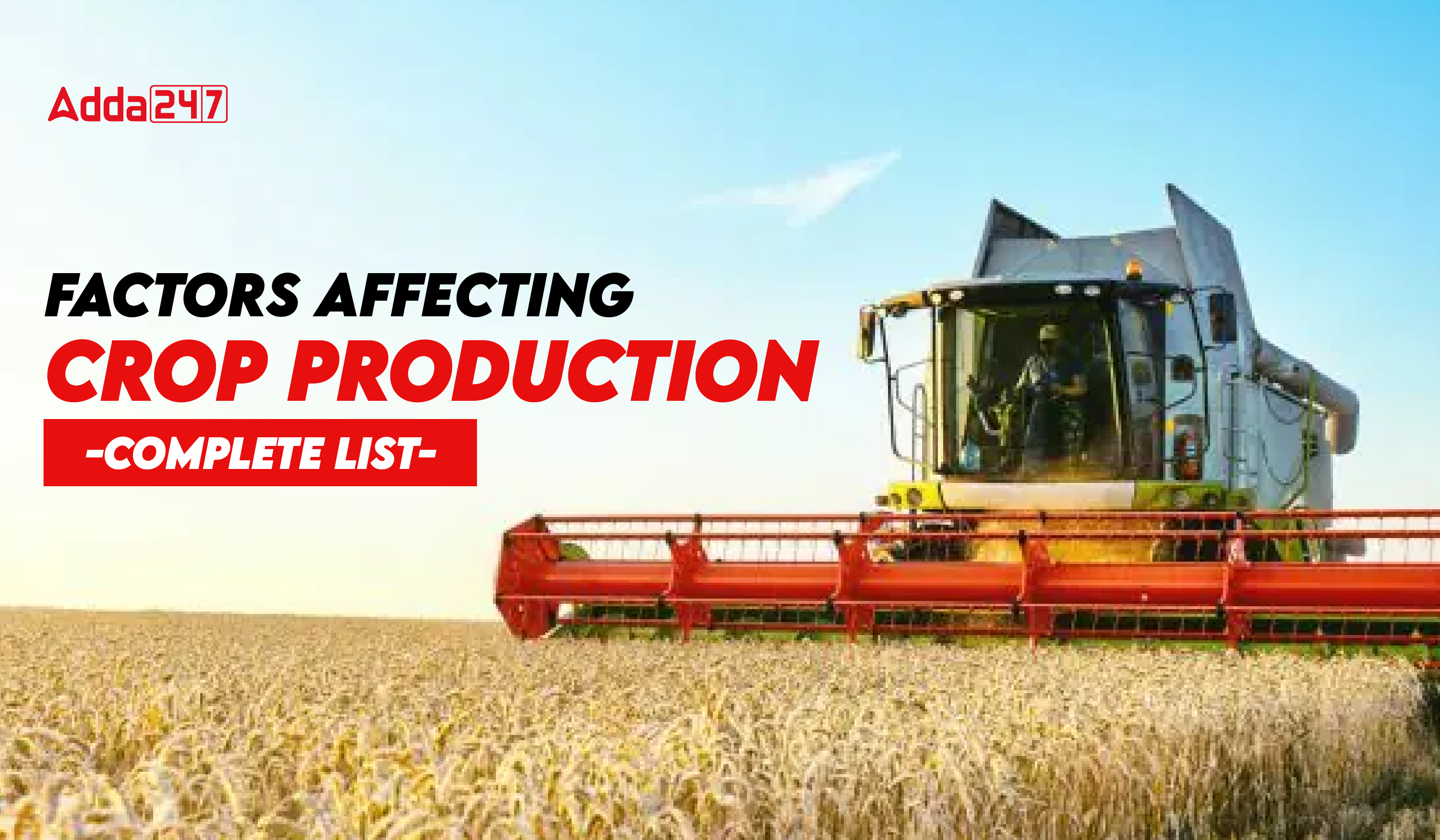Crop production means growing different plants to make food, and several things affect how well this works. For example, when you grow vegetables in your garden, the weather is very important; temperature and rain can help or hurt plant growth. The soil needs to be good quality, and plants require regular watering to do well.
You also need to watch out for pests and diseases, as they can damage your plants. Choosing the right seeds is key for a good harvest. All these factors work together to determine how well your plants grow and how much food you can produce. In the next article, we’ll look at each of these factors in more detail.
Factors Affecting Crop Production
Crop production is a complex process shaped by many factors. Its success relies on crop characteristics, environmental conditions, and socio-economic and political elements. It’s a mix of art, science, and business. Here are the key factors that impact crop production:
 Different Factors of Crop Production
Different Factors of Crop Production
Crop production relies on several important factors for success. The weather must be ideal, with a good balance of temperature and rainfall. Soil needs to be nutrient-rich and well-maintained, while consistent watering is essential for nourishing roots. Additionally, managing pests and diseases is vital to protect crops.
Farmers use various techniques and tools to boost growth and productivity. When these elements come together, it enables the cultivation of abundant, high-quality crops for all. Key factors affecting crop production include:
Internal Factors
Internal factors of crop production mainly involve genetic or hereditary aspects. Advances in genetics, including the development of new crop varieties and hybrids, have greatly increased crop production and productivity. These internal factors are primarily independent of external influences.
- Yield Potential: Some crop varieties are bred to produce higher yields, maximizing food output per land area.
- Disease Resistance: Certain varieties have genetic resistance to pests and diseases, reducing reliance on chemical pesticides and enhancing crop health.
- Drought Tolerance: Some crops are genetically designed to thrive in low-water conditions, making them ideal for arid regions.
- Pest Resistance: Genetic traits in some crops make them less appealing or more resilient to insect pests, minimizing damage from infestations.
- Environmental Conditions: Different varieties are suited to specific climates, including adaptations for cold, heat, and extreme weather like frost or hail.
- Nutrient Efficiency: Certain crops effectively utilize soil nutrients, decreasing the need for excessive fertilizers and enhancing nutrient uptake.
- Maturity and Growth Habit: Genetic factors influence the timing of flowering and fruiting, allowing for selection based on local growing seasons.
- Quality Traits: Genetics also determine qualities like taste, texture, color, and nutritional content, affecting consumer preferences and market demand.
External Factors
External factors affecting crop production are mainly environmental, encompassing various conditions and influences that impact crop growth and development. Approximately 50% of crop yield is attributed to climatic factors, which include temperature, rainfall, soil quality, sunlight, wind, humidity, and extreme weather events. These elements play a crucial role in determining the success of crop cultivation and overall productivity.
- Temperature
- Precipitation
- Solar radiation
- Atmospheric humidity
- Wind velocity
- Atmospheric gases
Temperature
Temperature plays a vital role in crop production by impacting various aspects of plant growth and development. Here’s how temperature affects crops:
- Temperature Measurement: It quantifies heat intensity, with most agricultural plants thriving in an ideal range of 15°C to 40°C.
- Geographical Influence: The location, including proximity to the equator and altitude, determines local temperatures, influencing which plants can thrive in that area.
- Plant Growth: Temperature affects leaf production, size, and flowering timing, as well as the processes of respiration and water uptake.
- Internal Processes: It influences the movement of gases and liquids within plants and affects the solubility of various substances.
- Temperature Tolerance: Each plant species has specific temperature requirements, including a minimum and maximum tolerance, along with an optimum range for growth, known as Cardinal Temperature:
- Minimum Temperature: The lowest temperature a plant can tolerate.
- Maximum Temperature: The highest temperature at which plant growth can occur.
- Optimum Temperature: The ideal range for optimal growth.
| Temperature of Different Crops | |||
| Crop | Minimum Temperature (ºC) | Optimum Temperature (ºC) | Maximum Temperature (ºC) |
| Rice | 10 | 32 | 36-38 |
| Wheat | 4.5 | 20 | 30-32 |
| Maize | 8-10 | 20 | 40-43 |
| Sorghum | 12-13 | 25 | 40 |
| Tobacco | 12-14 | 29 | 35 |
Precipitation
- Precipitation encompasses all forms of water falling from the sky, including rain, snow, hail, fog, and dew.
- Rainfall is crucial in shaping the vegetation and agriculture of an area, as its amount and pattern greatly influence which crops can be successfully grown.
- Regions with abundant and evenly distributed rainfall are ideal for crops like rice in flat areas and tea, coffee, and rubber in hilly regions.
- In contrast, areas with low and irregular rainfall often rely on dryland farming, cultivating drought-resistant crops such as pearl millet and sorghum.
- Deserts, characterized by scarce rainfall, typically support grasses and shrubs adapted to hot, dry conditions.
- Importantly, the timing and distribution of rainfall can be even more critical for successful crop production than the total amount received.
Solar Radiation
Solar radiation is essential for every stage of a plant’s life cycle, from germination to post-harvest. Here’s how it impacts plants:
- Biomass Production: Plants depend on sunlight for photosynthesis, the process that converts light energy into food, supporting growth and increasing their overall mass.
- Temperature Control: Sunlight helps regulate temperature, keeping it within the optimal range for plant growth, which is crucial for maintaining health and promoting effective growth.
- Photosynthesis: Sunlight provides the energy needed for photosynthesis, particularly through Photosynthetically Active Radiation (PAR) in the range of 0.4 to 0.7 micrometers. PAR is vital for producing carbohydrates, which are essential for growth and biomass production.
| Wavelength | Range (µ) | Color Activity Level |
| 0.4 – 0.5 | Blue-Violet | Active |
| 0.5 – 0.6 | Orange – Red | Active |
| 0.5 – 0.6 | Green – Yellow | Low Active |
- Day Length Matters: Some plants need short days to flower, while others need long days. Such as Rice, Sunflower, and Cotton: Short day (<12 hours); Barley, Oats, Carrot, and Cabbage: Long day (>12 hours); Tomato and Maize: Day-neutral (no specific requirement).
- Light Direction Matters: Plants grow toward light sources, like the sun, in a process called phototropism.
- Variety Sensitivity: Some plant varieties need specific amounts of light to grow properly.
Atmospheric Humidity
- Relative humidity is the ratio of the moisture in the air to its saturation capacity at a specific temperature, indicating how close the air is to being saturated with water vapor.
- It directly affects the water needs of crops; when relative humidity is high, plants may transpire less because the air already contains significant moisture.
- Most crop plants thrive in a relative humidity range of 40-60%, as this provides adequate moisture without causing excessive water loss through transpiration.
- However, very high humidity levels, particularly above 80%, can be detrimental, creating favorable conditions for pests and diseases.
Wind Velocity
Wind significantly impacts plant growth and crop production in several ways:
- Moisture and Heat Transport: Wind helps transport moisture and heat, both essential for healthy plant development.
- Carbon Dioxide Supply: Moving wind provides fresh carbon dioxide (CO2) for photosynthesis, which is crucial for plants to produce food.
- Optimal Wind Speed: A wind speed of 4-6 km/hour is beneficial for most crops, ensuring proper ventilation and even distribution of moisture and heat, enhancing growth.
- Mechanical Damage: Excessive wind speeds can cause physical damage, such as removing leaves and twigs, particularly harming delicate crops like bananas and sugarcane.
- Pollen and Seed Dispersal: Wind aids in the natural dispersal of pollen and seeds, essential for reproduction and genetic diversity.
- Soil Erosion: Strong winds can lead to soil erosion, carrying away topsoil and potentially reducing soil fertility, which negatively impacts crop growth.
- Cleaning Produce: Wind can help clean crops by blowing away dust, debris, and pests, reducing the need for manual cleaning for farmers.
Atmospheric Gases
- Atmospheric Composition
- CO2: 0.03%
- O2: 20.95%
- N2: 78.09%
- Argon: 0.93%
- Others: 0.02%
- Carbon Dioxide is crucial for photosynthesis, the process by which plants produce their food. Plants absorb it through tiny pores called stomata on their leaves.
- Oxygen (O2) is vital for the respiration of both plants and animals. Plants release oxygen during photosynthesis.
- Atmospheric nitrogen is fixed in the soil through processes such as lightning, rainfall, and nitrogen-fixing microbes, making it available to plants.
- Certain gases like sulfur dioxide (SO2), carbon monoxide (CO), methane (CH4), and hydrogen fluoride (HF) released into the atmosphere can be toxic to plants, affecting their growth and health.
EDAPHIC FACTORS (soil)
Plants grown on land completely depend on the soil on which they grow. The soil factors that
affect crop growth are discussed below.
Soil moisture
- Water essential for plant growth and photosynthesis
- Available moisture between field capacity and permanent wilting point
- Clay soil retains more moisture than sandy soil
Soil air
- Aeration essential for water absorption and germination
- Oxygen required for root and microbial respiration
- Facilitates nutrient availability and organic matter decomposition
Soil temperature
- Affects physical, and chemical processes, water absorption, and nutrient availability
- Influences seed germination and growth rate
- Controls microbial activity and nutrient processes
Soil mineral matter
- Derived from weathering rocks
- Provides essential plant nutrients (e.g., Ca, Mg, S, Mn, Fe, K)
Soil organic matter
- Supplies major, minor, and micro-nutrients
- Improves soil texture and water-holding capacity
- Source of food for microorganisms
- Aids nutrient release through decomposition
Soil organisms
- Decompose organic matter, releasing nutrients
- Fix atmospheric nitrogen for crop use
Soil reactions
- Decompose organic matter, releasing nutrients
- Fix atmospheric nitrogen for crop use
Biotic Factors
Growing crops depends on many things, like how plants interact, the animals around them, and the land’s features.
Plants
- Mutual benefits are observed when different crops (cereals and legumes) are grown together.
- Competition and complementarity among field crops when grown together.
- Examples of competition: Demand for nutrients, moisture, and sunlight; Weed-crop competition (e.g., Striga parasite on sugarcane).
Animals
- Soil fauna aid in organic matter decomposition (e.g., protozoa, nematodes, snails, insects).
- Some insects and nematodes cause crop yield damage.
- Beneficial organisms: Honey bees and wasps assist in cross-pollination, and earthworms aid in soil aeration and drainage.
- Large animals like cattle and goats can damage crops through grazing.
Physiographic Factors
- Topography: The nature of the surface earth (level or sloped) indirectly affects crop growth.
- Altitude: An increase in altitude leads to temperature decrease, precipitation increase, and higher wind velocity.
- Steepness of Slope: Steep slopes result in rainwater runoff and loss of nutrient-rich topsoil.
- Exposure to Light and Wind: Mountain slopes exposed to low light intensity and strong dry winds may lead to poor crop yields.
Socio-economic Factors
- Society’s inclination towards farming and availability of members for cultivation.
- Human choice of crops to meet food and fodder requirements.
- Breeding varieties for increased yield or resistance to pests and diseases.
- The economic conditions of farmers influence resource mobilization and input availability.



 OSSSC Village Agriculture Worker Eligibi...
OSSSC Village Agriculture Worker Eligibi...
 RSSB Agriculture Supervisor Selection Pr...
RSSB Agriculture Supervisor Selection Pr...
 RSSB Agriculture Supervisor Recruitment ...
RSSB Agriculture Supervisor Recruitment ...




 Adda247 Job portal has complete information about all Sarkari Jobs and Naukri Alerts, its latest recruitment notifications, from all state and national level jobs and their updates.
Adda247 Job portal has complete information about all Sarkari Jobs and Naukri Alerts, its latest recruitment notifications, from all state and national level jobs and their updates.



